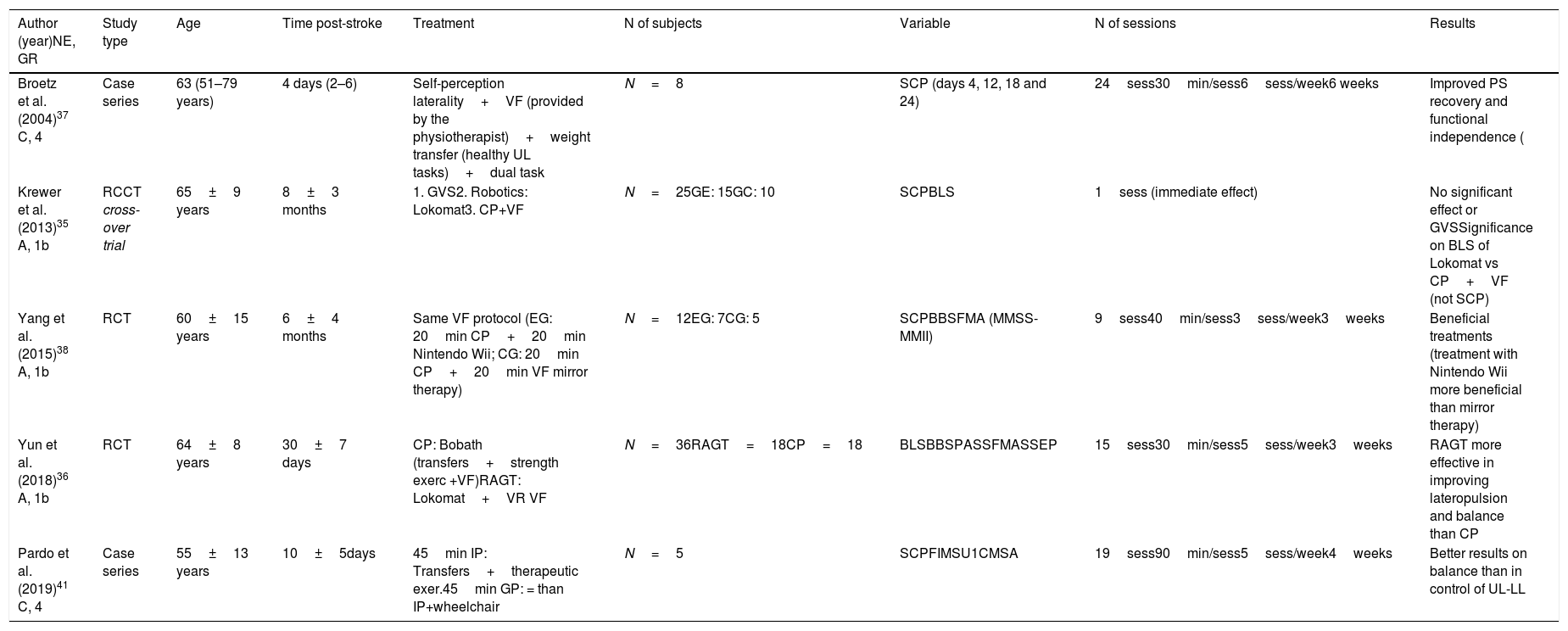Pusher syndrome is characterised by the patient pushing towards the hemiparetic side with the contralateral side, in a sitting position, standing and during movement, surpassing the gravitational mean line, which produces inappropriate adjustment and postural control.
ObjectiveTo determine the effectiveness of physiotherapy treatment in post-stroke pusher syndrome and to extract guidelines for its correct identification and interdisciplinary approach.
MethodA systematic review was carried out (2000–2019), using the specialised databases MEDLINE, Scopus, PEDro and Web of Science. The descriptors used in the search strategies were “pusher syndrome”, “pushing behaviour”, “controversial pushing”, treatment, “physical therapy”, physiotherapy.
ResultsAlthough the evidence is still limited, the intensive intervention of Physiotherapy in the patient with pusher syndrome post-stroke seems to improve the clinical symptoms in terms of severity and postural control. Among the different forms of treatment, training through visual feedback seems to be effective, especially using the Nintendo Wii balance platform.
ConclusionAn individualised physiotherapeutic intervention with each patient is necessary to facilitate and guide the most effective motor strategies, work synergies between the members of the interdisciplinary team are essential (with specific guidelines on transfers and functional activities between sessions) to ensure continuity of care that guarantees achievements are maintained.
El síndrome del empujador se caracteriza por un empuje del paciente hacia el lado hemiparético con el lado contralateral, en sedestación, en bipedestación y durante el movimiento, sobrepasando la línea media frente a la acción gravitatoria, lo que produce un inadecuado ajuste y control postural.
ObjetivoDeterminar la efectividad del tratamiento fisioterapéutico en el síndrome del empujador postictus y extraer pautas para su correcta identificación y abordaje interdisciplinar.
MétodoSe realizó una revisión sistemática (2000-2019), empleando para ello las bases de datos especializadas MEDLINE, Scopus, PEDro y Web of Science. Los descriptores utilizados en las estrategias de búsqueda fueron «pusher syndrome», «pushing behaviour», «controversive pushing», treatment, «physical therapy», physiotherapy.
ResultadosAunque aún la evidencia es limitada, la intervención intensiva de Fisioterapia en el paciente con síndrome del empujador tras sufrir un ictus parece mejorar los síntomas de este cuadro clínico en cuanto a la severidad y el control postural. De entre las diferentes formas de tratamiento, parece ser eficaz el entrenamiento a través de feedback visual, especialmente utilizando la plataforma de equilibrio de Nintendo Wii.
ConclusiónEs necesaria una intervención fisioterapéutica individualizada con cada paciente para facilitar y orientar las estrategias motoras más eficaces, siendo esencial las sinergias de trabajo entre los miembros del equipo interdisciplinar (con pautas concretas en transferencias y actividades funcionales entre sesiones) para llevar a cabo una continuidad de cuidados que garantice el mantenimiento de los logros obtenidos.
Article
Diríjase al área privada de socios de la web de la SEDENE, (https://sedene.com/revista-de-sedene/ ) y autentifíquese.







